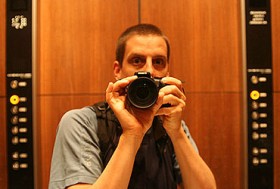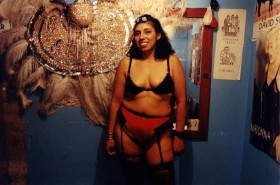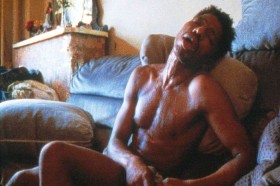Han siger, at han nu ved, hvordan det var, hvor forfærdende. Og Joshua Oppenheimer replicerer fra sin plads ved kameraet: Jamen, dine ofre havde det meget værre, de vidste, de skulle dø. Du ved, at dette er film. Anwar Congo er ikke sikker, hans højre hånd ryster krampelignende…
POWERFUL, SURREAL AND FRIGHTENING
Werner Herzog (comments) on Oppenheimer’s depiction of power and violence: “I have not seen a film as powerful, surreal, and frightening in at least a decade… unprecedented in the history of cinema.” And Errol Morris praises Oppenheimer’s portrayal of violence and cinematic imagination: “Like all great documentaries, ‘The Act of Killing’ demands another way of looking at reality. It starts as a dreamscape, an attempt to allow the perpetrators to reenact what they did, and then something truly amazing happens. The dream dissolves into nightmare and then into bitter reality. An amazing and impressive film.” (blogs.indiewire.com) Når Herzog og Morris siger sådan, bliver jeg mere end interesseret…
Og fra jeg som det første så traileren på Vimeo var jeg rystet, helt bogstaveligt rystet, selv om jeg forstod, det er rekonstruktioner, jeg så. For det er ikke fiktion, nej, det er omhyggelige genskabelser af erindringsbilleder. Ikke af fortrængninger, men af de mest forfærdende hændelser og gerninger, disse medvirkende lever med som deres liv. Som noget selvfølgeligt, forstår jeg. Jeg SKAL se den film om de indonesiske dødspatrulje-gangstere, som myrdede kommunister for magthaverne midt i 60’erne. (ABN 11-10-2012)
EDN INTERVIEW WITH THE PRODUCER
Signe Byrge Sørensen is CEO and producer at Final Cut for Real, which is located in Copenhagen, Denmark. She has been a producer for 14 years…
This is how an extended interview with the producer of the opening film of cph:dox starts, done by EDN (European Documentary Network) and to be found in its full length on the website of the organisation.
And it is indeed very good reading. Not only because it gives the background to the collaboration between Signe Byrge Sørensen and the director of the film, Joshua Oppenheimer, but also, actually first of all, because it gives a fine story about how a young Danish prodcer made her way from politically engaged, social documentary production in the financially good climate for documentary funding in Denmark, to now stand behind a film about which the director of dph:dox Tine Fishcer says: “The Act of Killing’ is like nothing else I have seen…” (TMS 24-10-2012)
www.edn.dk
IN A WAY THAT IS INESCAPABLE
… a film about which the director of dph:dox Tine Fischer says: “The Act of Killing” is like nothing else I have seen. It is radical in its political analysis and criticism, it is progressive in its combination of genres: gangster drama, glossy musical and surreal psychotic drama. And it sits with you in a way that is inescapable. It will become a film which will receive a prominent place in film history, and a film that everyone should see. Not only those with a particular interest in political documentary, but everyone who has the courage to face ‘the heart of darkness’. It never becomes black and white because even the most hardened executioner can be confronted with his own lies.” (TSM 24-10-2012)
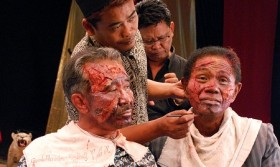
A TRUE STORY
Behind the scenes, the making of.. a film. We have seen them lots of times, following how the actors prepare for their roles, how the shooting was done, how the director directed. This is exactly what ”The Act of Killing” does, with the big difference that the film being made is, to use a kliché, ”based on a true story”. A story about the mass murder of around 1 million people in Indonesia in the 1960’es, opponents of the military regime. Communists. Chinese. The killers were saluted, and still are, as the films shows, through the paramilitary fascist group, now a political party, as I understood it, Pancasila.
Werner Herzog asked the protagonist in his masterpiece ”Little Dieter Needs to Fly” to reenact the horror actions he experienced in Vietnam, the directors of ”The Act of Killing”, an absolute masterpiece as well, have done the same with their killers – please re-constitute what you did at that time. And how you did it, we will help you to make your vision as authentic as possible. The filmmakers = the killers – they call themselves gangsters which they say mean ”free men” – choose different ways to convey their stories. They have found their inspiration in what they call ”sadistic movies” a la Scorcese and Tarantino, they have gorgeous more reportage style shooting from the streets, where extras are found, who can play communist family members, shot in observational style and with kids involved who break down as they do not know, whether this is for real or not and they make the most astonishing tableaux that make you think about Herzog and his Fitzcarraldo period.
But first of all the film has a fantastic main charismatic personality, the leader of the gang and the director of the film in the film, Anwar Congo. A Shakespearean character, haunted as he is by what he did. ”When I sleep it comes back to me”, ”a communist ghost”, he says, and the film is constructed around his journey from, as the cph:dox catalogue puts it, ”arrogance to regret”. Accompanied first of all by the fat man, of course his name is Herman(!), who does and has done all the atrocities he is told to do, and by the way tries to get into the Indonesian parliament(!) with Pancasila, Anwar Kongo lets his hair become black and goes from showing the most effective (= less blood) killing method to play a victim in his film, to getting sick in the end scene. Still you sit with the feeling that Anwar Congo, the charismatic grandfather, at any time would repeat the sentence ”all this talk about human rights pisses me off”, whatever the political situation in today’s Indonesia is. (Tue Steen Müller 08-11-2012)

GAROTTEN
Han sidder der ved det simple træbord. Over for ham sidder forhørslederen ved en skrivemaskine, og jeg ved, han ved, hvad der skal foregå. Siden jeg som stort barn så Poul Reichhardt i ”De røde enge” i en tilsvarende rolle over for en tysk forhørsleder har det siddet som traumatisk rædsel i mig. Jeg har vidst hvad der nu vil komme til at foregå. Nu kommer torturen. Jeg har i alle filmene siden (”Rom, åben by”, ”Slaget om Algier”… frem til ”Deer Hunter” måske, erindringen står af…), når den scene nærmede sig, set ned i biografgulvet og som den næste af de tre aber tillige holdt mig for ørerne. Til det var forbi. Siden jeg så traileren til ”The Act of Killing” har jeg på grund af den scene frygtet Oppenheimers film. Torturens forfærdende virkelighed og konstante mulighed og simultane aktualitet i denne verden. Og så skulle det i biografen den aften endda blive værre, meget værre, end jeg frygtede. Til mishandlingen føjede sig de allermest smertefulde ombringelser. Som på vore kirkers vægmalerier, som hos maleren Goya, specielt specialiteten: garotten.
Jeg havde fortrængt garotten, glemt massakren i landsbyen, som jo også var med i traileren. Nu sad jeg i biografen og forstod efterhånden lidt mere af det dokumentariske setup og mærkede, at filmen er ubehagelig på andre måder også (Herzog havde ligesom antydet det, og sådan var det), jeg fik lyst til at gå igen, til at flygte måske, blot liste ud af biografen. Jeg ville ikke være sammen med Oppenheimers medvirkende, jeg kan ikke lide de mennesker, de er latterlige, tror jeg først, men de er meget værre, viser det sig, de er rå, uvidende, pralende, brutale. Jeg skræmmes voldsomt ved deres særegent tydelige intimiderende tone, når de opkræver beskyttelsespenge hos de handlende, jeg kan lugte købmandens angst.
Klippet strammer udviklingen til. Jeg blev siddende i biografen, af høflighed mod min vært, men også fordi jeg burde. Det samler sig om én af de medvirkende mordere, Anwar Congo, om én af deres håndværks metoder, en slags primitiv garotte og om én scene, afhøringen ved træbordet. Det er Anwar Congo selv, der spiller den scene i filmens rekonstruktion af forbrydelsen, Han tager offerets rolle, og han får nu, lige der for mine øjne, indsigt i angstens overvældelse, indsigt i denne døds uendelige grusomhed.
Han siger, at han nu ved, hvordan det var, hvor forfærdende. Og Joshua Oppenheimer replicerer fra sin plads ved kameraet: Jamen, dine ofre havde det meget værre, de vidste, de skulle dø. Du ved, at dette er film. Anwar Congo er ikke sikker, hans højre hånd ryster krampelignende, da han mærker ståltråden om sin hals, da kvælningen finder sted. Er det film, eller er det virkelighed? En erkendelse har ramt ham, ham der længe, længe har været forfulgt af hændelserne dengang i sine drømme nu. Og nu er de blevet til pinefulde tanker i vågen, levende live.
“Det er en klassisk filmscene”, sagde Mads Brügger, som var vært i onsdags ved en kort spørgetid med Joshua Oppenheimer, “forbryderen opsøger stedet for sin forbrydelse.” Han talte om slutscenen. Og ja, de er jo filminteresserede disse mordere, det har de være siden dengang, de var unge og arbejdede som billetkontrollører i biografen. Over for biografen, på den anden side gaden, lå huset, hvor de i en lukket gård myrdede de mange mennesker. Anwar Congo viser beredvilligt derhen, han vil demonstrere deres enkle konstruktion, som sparede dem for al blodet på gårdspladsen: en ståltråd monteres, så han med enkle greb kan kvæle den ene efter den anden. Den ståltråd er central i filmen. I slutscenen, det er nat, opsøger Anwar Congo så, fulgt af Oppenheimer og holdet, endnu en gang denne lukkede gård. Han er denne gang i karrygult jakkesæt af silke, der har nok været aften i byen med de andre før dette spontane indfald, og i den opskruede tilstands svaghed overvælder stedets erindringer ham, og han kaster voldsomt op. I to omgange. Eller, der er vist ikke opkast tilbage, kun lidt slim at se og så mavens konvulsioner og en dødlignende rallen at høre. Det intellektuelt/psykiske gennembrud af empati fra scenen ved træbordet (som han i mellemtiden pralende har vist til sine to børnebørn på tv-skærmen derhjemme, hvor det ene barn dog nægter at se med) er blevet til et fysisk nedbrud eller et kroppens forsøg på renselse. Anwar Congo tørrer sig om munden med bagsiden af den højrehånd, som rystede. Forgæves som Lady Macbeth, der ikke kunne få blodet af sine hænder. Det er slutscenen.
Men der var to filmprojekter, og der er en slutscene mere. Anwar Congo og hans bande har et heroiserende spillefilmprojekt kørende inden i Oppenheimers dokumentarfilm. Og det projekts slutscene er ganske anderledes. Her står Anwar Congo i et storslået landskab med vandfald (igen denne renselse) klædt i kappe som profet og lader sig hylde af to af sine ofre, som vel som repræsentanter for alle de brutalt kvalte hænger en medalje i silkebånd om hans hals efter de har taget ståltråden af deres egne. Det er det sidste jeg mener at se til garotten.
Scenen får ikke slutningens plads, den sidder noget før, for Anwar Congo har, forstod jeg på Joshua Oppenheimer, afstået fra dens opdigtning til fordel for en ærlig dokumentation af et ægte sammenbrud. ”Han er modigt gået ind i mørkets hjerte”, sagde instruktøren under samtalen efter filmen. Måske, måske tænker jeg, men tøver. Indsigten i disse menneskers tanker og handlinger er en voldsom udfordring til min empati og tøvende forståelse. Her mangler jeg Oppenheimers stemme inde i filmen. Han er der konstant på sin plads ved kameraet, jeg hører korte bemærkninger, men der er ikke dette trygge (og dog mindst lige så foruroligende) essay, der hos Herzog som fortællerstemme er med mig konstant. Oppenheimer lader være, og styrende for filmens indre overvejelse, det tavse essay af voldsomme billeder og råben og skrigen, overlader til mig selv at tænke mit eget tavse essay over mysteriet om dette andet menneske, som jeg afskyr og dog er afhængig af – det skræmmer mig usigeligt. Mest skræmmende er måske den unge tv-vært, som muntert lader sig imponere af forbryderne i sit studie og af deres pral med metoden med ståltråden. Hendes smilende overfladiske kynisme fatter ikke garottens virkelighed. (Allan Berg Nielsen 10-11-2012)
THE ACT OF KILLING WINS IN BERLIN
…of course it does, two awards, the Ecumenical and the Audience Panorama Award. What is more important to notice is the speech given by one of the directors, Joshua Oppenheimer, when he accepted the Ecumenical Award. Here you are:
The perpetrators we filmed in Indonesia destroyed other human beings for money and for power. This greed, unfortunately, is all too human. After killing people, the perpetrators felt trauma, even remorse. This, too, is human. And so they needed excuses, propaganda, so that they could live with themselves, so that they could kill again, and then go on to build a regime on the basis of terror, lies, and the celebration of mass murder.
The new dictatorship quickly obliged, making up lies to rationalize what they had done. Through these lies emerged a distorted morality to justify evil, even to celebrate it.
Among the most effective of these lies is that the victims were atheists, and that non-believers have no place among the living. The killers themselves know that their victims were not atheists. And we know that it does not matter. But in Indonesia, atheism is still equated with evil. And this remains a pillar in the justification of genocide. THE ACT OF KILLING has been accused of being a film by and for atheists.
Since International Human Rights Day on December 10, 2012, The Act of Killing has screened hundreds of times in Indonesia, in more than 90 cities. It has helped give rise to a national conversation in which, finally, the silence around the genocide has been broken, and Indonesians are openly discussing how today’s regime of corruption and fear is built on a mountain of corpses. Necessarily, the distorted morality, in which the victims are represented as “evil” atheists, is starting to crumble.
We thank the Ecumenical Jury for this prize: it is an important contribution to our effort to break the silence. In itself, this award exposes lies that have, for so long, been used to justify crimes against humanity, to stigmatize survivors, to keep people afraid. Your decision to give this award to THE ACT OF KILLING confirms that when religion is used as a justification for crimes against humanity, it has lost its moral foundation. We thank you. Indonesia thanks you. (TSM, post 16-02-2013)
DOCSBARCELONA 2013
… Producer Signe Byrge represented and presented ”The Act of Killing” in a brilliant way giving basic background information about this most talked about and praised documentary in the last year. It was the director’s cut that was shown at DocsBarcelona, 159 minutes, and seeing it on a big screen with almost 200 people makes a difference, of course. Signe Byrge talked about the screenings in Indonesia and stressed that the film is not a historical film about the killing of communists in the country in the mid 1960’es, it is a film about Indonesia today with the militant paramilitary groups still very much present and active. (TSM, post 02-06-2013)
ERROL MORRIS
New York Times brings a long article about “The Act of Killing”. Errol Morris, credited, as Werner Herzog, as executive producer, has these words about the film, when asked if it is a documentary:
““Of course it’s a documentary,” he said. “Documentary is not about form, a set of rules that are either followed or not, it’s an investigation into the nature of the real world, into what people thought and why they thought what they thought.”
But Mr. Oppenheimer (Joshua O. directed the film) offered a more nuanced view. He distinguishes between the observational style of the film’s first half and what comes after it pivots to the re-enactments
“I think it almost stops being a documentary altogether,” he said. “It becomes a kind of hallucinatory aria, a kind of fever dream.” At that point, he added, the film “transcends documentary” and becomes a strange hybrid creation.
But no matter what you call it, Mr. Morris said “The Act of Killing” was a work of art. Prefacing his remarks by saying, “I think I can speak independently of my role as executive producer, because I have no financial interest in this film,” he continued: “The most you can ask from art, really good art, maybe great art, is that it makes you think, it makes you ask questions, makes you wonder about how we know things, how we experience history and know who we are. And there are so many amazing moments like that here.” “ (TSM 15-07-2013)
BALTIC SEA DOCS 2013
Full house for the opening film of 2013 Baltic Sea Docs, “The Act of Killing”, director’s (Joshua Oppenheimer) cut (editor Niels Pagh Andersen), 158 mins. The film was screened not only in Riga but also in three other Latvian cities/towns: Liepaja, Valmiera and Jekabpils, where the audience also had the chance to follow the 50 mins. long Q&A session with the Danish producer of the film, Signe Byrge Sørensen.
It was not the first time that I attended a session with the producer of this all-over-world-going film. And it was not the first time that I left the cinema full of admiration for the professional and personal way Signe Byrge addressed the audience giving it precise, inside and interesting background information on the making of a film that was 7 years on its way with her on board five years.
Signe Byrge is CEO and producer of the company Final Cut for Real, here is its profile taken from the website: Final Cut for Real is dedicated to high-end creative documentaries for the international market. Our policy is to be curious, daring and seek out directors with serious artistic ambitions. We do not from the outset set any limits on subjects or locations. We look for interesting stories, great characters and in-depth social analysis – and we also try to give the films a twist of humour.
Our method is for our producers to work closely with “their” directors from the first idea to the final film, and keep on exchanging ideas and feedback. Together we cover a wide range of development and production expertise – and work with younger talent as well as established filmmakers to create a productive mixture of experience and new approaches to documentary filmmaking. (TSM, post 05-09-2013)
NORDISK PANORAMA 2013
No surprise in Malmø where the The Best Nordic Documentary Award was given last night to ”The Act of Killing”. Here is the motivation of the jury (Christian Bonke (director), Cara Cusumano (Tribeca Film Festival), and Kate Townsend (BBC Storyville)):
The jury would like to thank Nordisk Panorama for inviting us to be part of your fantastic event this year, and to experience the quality and range of work on display from all the Nordic countries. The films consistently impressed us with their powerful messages and intimate access.
At one moment we were transported by the bittersweet memories of a failed romance in Paris, and the next found ourselves surprised by the unexpected humor and vitality in a women’s prison in Afghanistan. Also we met the young boys from warzones around the world trying to get a bit of shelter in our western welfare. Congratulations to all the filmmakers on these great works, and thank you for sharing with us.
For the 2013 Best Nordic Documentary Award, the jury has chosen to recognize a unique achievement in the landscape of non-fiction filmmaking, a crucial work which shines a light where there had been only darkness and deceit, at the same time as it forges a new path in documentary for future filmmakers to explore. For its groundbreaking approach to the documentary form, and its unflinching confrontation with atrocity, mendacity, and the human face of evil, the jury awards the 2013 prize to Joshua Oppenheimer’s The Act of Killing. (TSM 25-09-2013)
OPPOSITION MERIN AND FRASER
Jennifer Merin, American film journalist and critic, has again and again written against “The Act of Killing”, some days ago when it was awarded 2 big prizes at the Cinema Eye Honors. Merin is not the only one, BBC Storyville editor Nick Fraser agrees (with different arguments) with her opposition. The link below will take you to both Merin’s review and to Fraser’s opinions. A quote from Merin’s blog:
“The below published article is a preview of a longer piece that will appear in the next edition of Film Quarterly. In it, noted BBC Commissioning Editor and documentary film authority Nick Fraser comments on The Act of Killing, a film that has attracted supporters, garnered awards and been named to the 2014 Oscars shortlist…
… Fraser’s opinions are eloquently phrased in this preview, which he so graciously sent to me with his consent that I publish it exclusively at Documentaries.About.com.” (TSM, 13-01-2014)
DRABETS HANDLING
af Allan Berg Nielsen
Noget post festum kan man hævde, da filmen jo nu er forsvundet fra aviserne og tv og Facebook, men i stedet for det så til gengæld godt inde i det ganske almindelige verdslige studium af filmens kunst og naturligt der var der forleden aften på Den Skandinaviske Designhøjskole filmaften. Vi skulle se og tale om Joshua Oppenheimers ”The Act of Killing” og helt fri af konkurrencernes tummel forsøge at koncentrere os om filmens arkitektur og indre liv, dens set-design, kameraarbejde og klip og dens idé, tænkning og story line. Det var selvfølgelig ikke amatør filmvidenskab, det var bare ganske almindelig publikumsfascination i et forsøg på at nærme sig det rystende indhold, filmens tunge viden om det onde menneske, om drabets handling.
Dagen før filmaftenen med ”The Act of Killing” havde forstanderen på Den Skandinaviske Designhøjskole omdelt min tekst om torturen og garotteringen. Den er skrevet lige efter, jeg så filmen ved premieren, og den var slået i spisesalen op som plakat med still fra filmen. Så højskoleeleverne vidste, at aftenens oplægholder havde problemer med filmen, de skulle se. Det tog jeg så udgangspunkt i, da jeg kort skulle introducere filmen. De følgende afsnit er mine notater til (og efter) den introduktion.
Jeg gjorde de mange højskoleelever klart, at det var med største uvilje, at jeg genså filmen. Men jeg sagde også, at jeg havde set den nogle gange efterhånden, og jeg opdagede stadigt nyt i filmen og nyt i mig selv. The Act of Killing er en titel med dobbelt betydning. Det en kontemplation over drabets handling og en isceneættelse, en teaterhandling af drabet, drabene et et halvt århundrede senere. Jeg nævnte også, at titlen forbinder sig med Kieslowskis filmiske overvejelse af Dekalogens femte bud, ”Du må ikke slå ihjel”, afsnittet i den store tv-serie udvidede han til en biografversion med titlen ”Kunsten at dræbe”. Act, handling, teater, film, kunst…
Og publikum denne aften var jo netop unge kunststuderende, de var alle på en af fire retninger: arkitektur, møbler, tøj, grafik. Og så ville jeg trække fire af kunstnerne, håndværkerne frem for dem, give dem en ganske kort biografi. To filmfolk med universitetsuddannelse og to med filmskoleuddannelse:
JOSHUA OPPENHEIMER
Amerikansk filminstruktør. Født og opvokset i Texas, uddannet i filmvidenskab fra universiteterne Harvard i Cambridge, Massachusetts og Central Saint Martins College of Art and Design i London. Han bor nu i København og han arbejder der, har efter ”The Act of Killing” færdiggjort en film mere, som er i dansk distribution: ”The Look of Silence”(2013).
SIGNE BYRGE SØRENSEN
Dansk producer, cand.com. i Internationale udviklingsstudier og Kommunikation fra RUC. Har siden universitetet arbejdet som producer på dokumentarfilm og blev i 2004 ansat som producer ved Final Cut Productions, overtog i 2009 selskabet og omdannede det til Final Cut for Real.
LARS SKREE
Lars Skree er filmfotograf fra Den Danske Filmskole. Han har været fotograf på “Fra Thailand til Thy” og “Fra Thy til Thailand”, som begge er instrueret af Janus Metz. Og han har fotograferet Metz’s hovedværk ”Armadillo”. Ham valgte jeg at gøre lidt ud af over for præcist disse højskoleelever. Netop om ”Armadillo” har Skree sagt noget vigtigt om det kunstneriske. I et interview blev han spurgt: ”er ’Armadillo’ en nysgerrig film?” Og han svarede udenom for at nå sin pointe: ”Armadillo er en poetisk, ja, filosofisk film om, hvad der sker med mennesker, der agerer i den yderste grænse. Ikke fordi filmen giver mange svar, mere med de spørgsmål eller tanker den rejser. Det er ikke en konfliktbåret film, og vi har ikke på forhånd haft en bestemt holdning, som vi skulle fodre folk med. Tilskuerne må selv tage stilling…” Jeg tror det også har været sådan med ”The Act og Killing”.
NIELS PAGH ANDERSEN
Niels Pagh Andersen er dansk klipper, begyndte da han var en stor dreng som klippeassistent hos mesteren Christian Hartkopp, en mytologisk skikkelse i dansk film. Han holdt ved og har klippet lige siden og ind imellem undervist i faget og er nu på vej til selv at være den store, gamle mester. Jeg havde tænkt, at jeg ville fortælle om hans arbejde med de tre film, ”Welcome to Denmark” (Moe), ”Three Rooms of Melancholia” (Pirjo Honkasalo), ”Den tyske forbindelse” (Lars Johansson), men nåede det ikke. Til gengæld opstillede jeg på grundlag af dette referat, som Tue Steen Müller har skrevet efter en masterclass, Pagh Andersen engang holdt, at opstille 7 regler om film og klipning:
NIELS PAGH ANDERSEN’S RULES
af Tue Steen Müller
”Film is an emotional stream, Niels Pagh Andersen said, Danish editor, living in Finland, and working with films from many different countries. TV documentaries, feature duration docs for cinemas. Andersen has a long and strong cv. And he delivered an inspiring lecture. He started saying that we all want to bring order in chaos, don’t we? At least this is the job of an editor. Simplify, he said again and again, and referred to some drawings of Picasso, where he (Picasso) found the essence of a bull. The essence, find that, you get much deeper, the simpler you put things. If you want to teach something particular, write a book!
Give a minimum of information, Andersen emphasized, get to the emotions. Look for the inner development of the characters and hold back information, don’t tell everything up front. Create expectations, let the audience work, communicate that ”something is going to happen”. And remember the aspect of identification. He showed two clips – one from the ”Cities on Speed” series, ”Mumbai Disconnected” (2009) by Camilla Nielsson and one from ”Prostitution Behind the Veil” (2004) by Swedish Nahid Persson. For the last one, Andersen stressed how important it is to build up a sympathy for the characters, he used the word love, in this case two mothers, and prostitutes, who you get to know later in the films from a more dark side in their relation to their children…”
Altså:
1
Film er en strøm af følelse…
2
Vi ønsker alle at bringe orden i kaos, ikke sandt? Se, netop det er klipperens arbejde…
3
Vi kender alle Picassos tegninger af tyren under kampen i arenaen, forenklingen ved et minimum af streger, forenklingen til tyrens essens… Find essensen, jo simplere du kan lave værket, jo dybere kommer du…
4
Hvis du vil lære os noget mere, belære os, så skriv en bog… Er det film, så giv et minimum af information, gå direkte til følelserne…
5
Led efter karakterernes indre udvikling og hold igen med informationerne, fortæl ikke alt i begyndelsen… (og jeg forberedte de unge tilskueres opmærksomhed på, hvad der sker inde i den medvirkende Anwar Congo. Ja, det var jo egentlig lidt forkert lige før visningen, men vi var jo på en skole og jeg sagde vel at mærke ingenting om den store slutscene…)
6
Skab forventninger, få publikum til at arbejde… Kommuniker, at noget vil ske (”something is going to happen”)…
7
Og husk identifikationens aspekt… (Jeg fortalte, at jeg altid søger en ”at holde med”, og har det skidt med filmen her, jeg kan ikke holde med Congo og Oppenheimer, som er min naturlige helt, er meget diskret til stede, for mig for diskret…)
Opbygge sympati for karaktererne… NPA bruger selv ordet ”love”… og det er også mere end svært her, det interessante her er at Pagh Andersen alligevel er på vej med især Congo og Hermann… hvad der er afgørende for filmens konstruktion over en strøm af følelser.
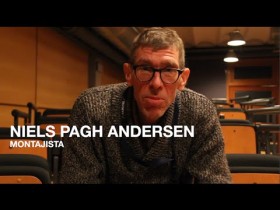
Pagh Andersen workshop, se klip her og her
NICK FRASER
Filmen er rost næsten overalt, af næsten alle kritikere. Men ikke af Nick Fraser, den mangeårige redaktør af BBC’s Stroryville dokumentar program, forbilledet for det danske Dokumania. Han skriver i en artikel, The Guardian bragte, kort efter at BAFTA havde valgt den som årets dokumentarfilm, at filmen undersøger omstændighederne, hvorunder en halv million indonesiske venstrefløjsfolk blev myrdet i 1960’erne på foranledning af en regering, som stadigvæk har magten. Og det er sædvanligvis et emne for en film for skeptiske historieinteresserede en sen aften, men nej, Oppenheimer har gjort noget opsigtsvækkende, han har inddraget nogle af morderne som medvirkende. Han har tilbragt et par år med at hænge ud sammen med dem, og ikke alene det. Han har fået deres hjælp til at iscenesætte mordene, rekonstruere dem i filmen. Og bortset fra hovedpersonen Anwar Congo som mod filmens slutning viser små tegn på fortrydelse, lever de i en tilstand af frygtløshed over for mulig hævn eller straf. De er tværtimod set op til og beundret for deres fortid. Jeg opsummerede Frasers indvendinger:
1
Fraser kan simpelthen ikke lide og slet ikke anerkende den både æstetiske og moralske præmis, at få mordere til at genskabe deres mord til brug for biograf og tv… de nyder det oven i købet smaskende…
2
Fraser spørger etorisk, om det ikke havde været bedre, om vi havde hørt om mordernes ofre? At filmen fortalte noget om dem, hvis liv, de tog?
3
Fraser konstaterer at filmen ikke udvider ikke vores viden om og forståelse af massedrabene i Indonesien eller afdækker den antikommunistiske kult i landet…
4
Og han konstaterer i en fortsættelse, at vi i stedet for at se resultatet af en undersøgelse er endt et andet sted, i en ”high-minded snuff movie”, en højtbegavet dødsporno-film…
JOSHUA OPPENHEIMER
Instruktøren skrev i The Guardian et indirekte svar til Nick Fraser… Uden at nævne ham… han skriver blot i en opsummering af filmens modtagelse hos kritikerne: ”en enkelt kommentator har endog sammenlignet den med en snuff movie…” Jeg gennemgik hans artikel i en række punkter:
1
Filmen er følelsesmæssig indtryksfuld, ikke voldeligt indtryksfuld…
2
Før han opsøgte morderne foretog han over otte år research hos og sammen med de overlevende…
3
De ville ikke medvirke i filmen, turde ikke på grund af regimets kontrol, men overtalte ham til i stedet at filme forbryderne…
4
Det gik der to år med… Anwar Congo var vidne nr. 41…
5
Hele tiden gennem denne fase var Oppenheimer i kontakt med de overlevende og med menneskerettighedsorganisationer…
6
Filmen er ikke pornografi oganden underholdning, den er en demonstration af et nutidigt samfund, et frygtens og rædslens regime fra vore dage …
LARRY ROHTER
Så fortalte jeg om medarbejderen ved New York Times, Larry Rohter, som præsenterede og anmeldte filmen meget stort. Han slutter sin tekst med citater fra et interviw han havde med Joshua Oppenheimer og filmens executive producer, forfatteren og filminstruktøren Errol Morris og skriver: ”I betragtning af alle disse emner, forekommer det nu mere end passende at spørge om ’The Act of Killing’ overhovedet er en dokumentarfilm?” Errol Morris, som har tænkt over og skrevet om dette emne betragteligt længe og mange gange gennem sit liv, er ikke i tvivl. ”Selvfølgelig er det en dokumentarfilm, ” siger han. ”Dokumentarfilmgenren er ikke bestemt af formen, af et sæt regler, som enten følges eller ikke, det er en undersøgelse ind i naturen af den virkelige verden, langt ind i, hvad mennesker tænker og hvorfor de tænker det, de tænker.”
Og Oppenheimer kunne tilføje et endnu mere nuanceret synspunkt. Han skelner mellem den observerende metode i filmens første halvdel og hvad der kommer efter, i anden halvdel, hvor den hengiver sig til iscenesættelserne. ”Jeg tror, det alt sammen her nærmest holder op med at være dokumentar”, siger han. ”Det bliver en slags hallucineret arie, en feberdrøm af en slags. Her…” tilføjede han, ”transcenderer filmen dokumentarformen og bliver en mærkelig hybrid skabelse.”
Men lige meget hvad du kalder det, sagde Morris, “The Act of Killing” er et kunstværk, og han fortsatte: ”Alt hvad du kan forlange af kunst, virkelig god kunst, måske stor kunst, er, at den får dig til at tænke, får dig til at stille spørgsmål, får dig til undre dig over, hvordan vi ved ting, hvordan vi oplever historie og hvem vi er. Og der er SÅ mange forbløffende øjeblikke som disse i filmen her.”
http://www.theguardian.com/film/2012/sep/14/act-of-killing-review (Anmeldelse i The Guardian efter Toronto festivalen: ”… det er festivalens bedste film.”)
http://www.theguardian.com/film/2013/jun/27/the-act-of-killing-review (Anmeldelse i The Guardian: ”Oppenheimer giver dem mere end reb nok til at hænge sig selv…”)
http://www.theguardian.com/commentisfree/2014/feb/23/act-of-killing-dont-give-oscar-snuff-movie-indonesia (Nick Frasers kommentar: ”… denne smagløse film lærer os ingenting…”)
http://www.nytimes.com/2013/07/14/movies/the-act-of-killing-and-indonesian-death-squads.html?pagewanted=all&_r=1& (Larry Rohters anmeldelse og interview med Errol Morris og Josua Oppenheimer)
http://documentaries.about.com/od/Guest-Commentaries-on-Documentary-Films/fl/WE-LOVE-IMPUNITY.htm (Jennifer Merin kommenterer og bringer en version af Nick Frasers tekst)
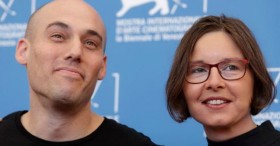
SIGNE BYRGE SØRENSEN
Produceren Signe Byrge Sørensen er på vej til internationale festivaler i Venedig og Toronto med sin nye dokumentarfilm “The Look of Silence”, Joshua Oppenheimers opfølger til “The Act of Killing”, der denne gang giver stemme til ofrene for det indonesiske folkemord i 1965-66.
Signe Byrge Sørensen grundlagde Final Cut for real i 2009. At hun kun fem år senere skulle optræde på den mest glamourøse af Hollywoods røde løbere, oscarnomineret for den kontroversielle “The Act of Killing”, havde den beskedne producer nok ikke forestillet sig. Men udsynet og lysten til at formidle globale problematikker på film har været en drivkraft i hele Signe Byrge Sørensens professionelle liv. Det samfundsmæssige engagement kombineret med en enorm arbejdsomhed, analytisk skarphed og stort mod har gjort hende til en dybt respekteret producer blandt kolleger i både Danmark og udlandet.
Roos Prisen gives for en bemærkelsesværdig indsats for dansk dokumentarfilm, og priskomiteen uddyber valget af den 44-årige producer således:
En filmproducer kan være – men er ikke nødvendigvis – en kreativt drivende kraft. Signe Byrge Sørensen er meget mere end en kreativ producer. Hun har med “The Act of Killing” vist sig som visionær producer i verdensklasse. Hun så potentialet i Joshua Oppenheimers materiale, der bestod af mere end 1000 timers optagelser. Hun etablerede et professionelt, kreativt rum omkring ham, som gjorde, at det monstrøse materiale kunne forløses til en film, der på alle måder er nyskabende og bemærkelsesværdig. Hun skabte det økonomiske rum, og hun sørgede med en vedholdende strategisk indsats for, at filmen kom ud i verden og fik den fortjente opmærksomhed fra både kritikere, publikum og politikere.
Blandt kolleger i filmbranchen bliver Signe Byrge Sørensen fremhævet for sit intellekt, sin seriøsitet, sin fordomsfrihed og enorme vedholdenhed. Hvis Signe har påtaget sig en opgave, tager hun det fulde ansvar: det produktionsmæssige, det kreative, det etiske, det politiske osv. Og man skal absolut ikke lade sig narre af den ydmyge fremtoning. Signe Byrge Sørensen ved, hvad hun vil opnå, og går venligt, men bestemt efter det.
For os alle er det en gave, at det, som Signe Byrge Sørensen overordnet går efter, er at bidrage til en bedre verden med større lighed og social retfærdighed. Med film, der indimellem slår benene væk under publikum. Produceren selv står fast, hvad enten det er på den røde løber eller blandt syriske flygtninge, som er tema for et af Signes kommende filmprojekter. (TSM 24-08-2014 / Det Danske Filminstitituts pressemeddelelse om ROOS PRISEN 2014)
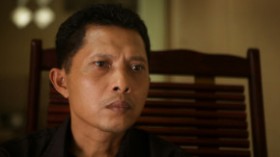
THE LOOK OF SILENCE 2014
af Tue Steen Müller
It’s horrifying, it hurts to watch the scenes that shows these brutal perpetrators re-enact their killings committed around 1965 in Indonesia, where the slaughtering of communists were performed by a military regime and its gangs that had come into power. One million were killed. The Americans (and the rest of the world?, at least we did not hear about it, or did we?) made no objections as an American NBC news clip shows in this second Descent to Hell, Indonesia 1965 and today, the first being ”The Act of Killing”. This time seen from the point of view of an opthalmologist, Adi, a man in his forties with wife and two children, a mother and a father – and a brother, Ramli, who was killed back then.
The overall theme of the film is the same, yet ”The Look of Silence” is completely different from ”The Act of Killing”, that framed the story of the perpetrators horror by having them make their film about the act of killing. Surrealistic scenes came out of that, to say the least. Whereas ”The Look of Silence” brings Adi to the centre to make him meet old men in the neighbourhood, men who took part in the atrocities. He comes to check their sight and starts to ask about the past. He gets to know more and more and ends up discovering the involvement of his own family – an uncle was a guard in the prison that Ramli was taken to before he was – that is the word being used – hacked into pieces! Adi gets to know all the details about how his brother was murdered.
The slow rythm is different to ”The Act of Killing”. You are taken to a place, where the cikades are singing, a soothing sound to beautiful images (cameraman Lars Skree) surrounds the horrors that Adi quietly watches on a tv set, filmed by Joshua Oppenheimer a decade before. In this material the killers enthusiastically demonstrate how they dragged the victims to the Snake River to throw them into the water after their deed. In a unique scene Adi walks with Kemat to the Snake River, no words from their mouths but a touching voice-off text from the survivor.
Adi keeps a straight face until he meets an old killer and his daughter. The old man talks about drinking the blood of the victims, ”so you don’t get crazy”, another says the blood is ”sweet and salty”, he is senile, says the daughter, please forgive him, she has never heard about his past before, she is shocked and touched, they hug each other before Adi leaves.
Adi as a film character is gold. You are with him from the very beginning, you watch the warm scenes with his old mother – ”you are the answer to my prayers” – he was born two years after Ramli was killed – you see his lively children and his wife, who is more than worried that he has taken upon him the role of finding out what happened in 1965. It can not have been an easy decision for him to agree to take part in a film about killers, who are still alive in a country where they are considered heroes – and where the school kids, including Adi’s son, are taught that what happened was fair and right!
Any objections? No, ”The Act of Killing” and ”The Look of Silence” will stay as monumental works in the history of documentary films both in terms of the content information that is brought to us and in the cinematic way that this is conveyed. The mere fact that Oppenheimer and his many anonymous helpers have been able to make these two films deserves deep respect.
An additional remark re: ”The Look of Silence” – Oppenheimer and his editor Niels Pagh Andersen have now reached a kind of perfection in storytelling… Step by step information is given, the family is introduced and included, no stone is left unturned, the perpetrators and their families, step by step Adi knows more, step by step he gets closer to the cruel facts about his brother, the atmosphere becomes more and more intense, emotional impact on Adi and the viewer is growing, and we know that he has to show his despair explicitly… Can a film be too perfect? (05-11-2014)
Denmark, Indonesia, Norway, Finland & UK, 2014, 98 mins. The film is shown at cph:dox in Copenhagen.
www.thelookofsilence.com
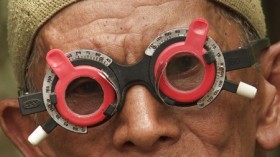
THE LOOK OF SILENCE 2014
af Allan Berg Nielsen
Jeg ser ikke Oppenheimers to film frivilligt, de er ubærligt forfærdende. Jeg ser dem af den slags pligt, det er at blive konfronteret med selve sandheden. Den sandhed om mennesket, at det har en grusom side. Ikke blot konfronteret som filosofisk tanke, nej som omhyggeligt udpenslet, konkret teknisk detaljeret virkelighed. Måske har jeg en grusom side gemt af vejen, men til stede et ikke utilgængeligt sted? Dette er rystelsen, tvivlen og sandheden.
I ”The Act of Killing” var det TORTUREN og dens intimiderende virkning, den rædsel, som holdt mig tilbage fra filmen, fik mig til at se væk, holde mig for ørerne. Garotteringen, som også skildredes i filmen, glemte jeg i psykisk forsvar øjeblikkelig. I Oppenheimers nye forfærdende film, ”The Look of Silence”, er min rædsel OMBRINGELSEN, ikke drabet som sådan, men metoden ved jeg, for nu har jeg så for nogen tid siden set ”The Look of Silence”, og straks lagt den til side, glemt den. Jeg kan ikke huske den film, jeg fortrænger den film, jeg kan altså ikke leve med de erfaringer, jeg fik ved gennemsynet for nogen tid siden. Jeg ser på mine notater, men de lukker sig, de vil ikke åbne for hvordan det nu var med den eller den scene. Slet ikke scenen ved floden. Snake River.
Jeg ser altså på mine notater, der står, at åbningen af filmen er et chok af nærvær. Den gamle mand vaskes, jeg ser den nøgne, ældede krop så tydeligt. Hans kone vasker ham omhyggeligt i en lang scene, og jeg mener blufærdig, at jeg bør se væk. Og så har jeg noteret, at hovedpersonen er optiker, og jeg forstår med ét det still, som i mange måneder har introduceret filmen, disse voldsomme briller på et ansigt. Hovedpersonen er jo optiker og sætter i sit arbejde denne prøvebrille på sine klienter. Det er optikeren, jeg følger. Det næste er, at den gamle mand synger en erotisk sang. Igen bliver jeg genert, men sex er sært nok et vigtigt tema i denne film.
Så har jeg noteret, at filmen er klippet i scener. Se, her bliver jeg rolig, her kan jeg skrive om filmgrebet, jeg holder så meget af, dokumentarfilm bygget op af scener, som roligt afløser hinanden i et billedmæssigt forløb, et emotionelt forløb, her er det så opbygningen af en rædsel i mig, og grunden under min samfundsforståelse vakler, der gives altså helt andre grundlag. Læreren underviser om kommunisterne som noget farligt og umenneskeligt. Den unge far, optikeren snakker med sin søn og modsiger hvad læreren har fortalt.
Han sidder og ser Joshua Oppenheimers optagelser med bødlernes erindringer. Bødlerne ler, mens de fortæller. Så møder jeg den overlevende i dødsrækken. Det her fortsætter i et roligt tempo. Nu er jeg disse mange år senere med bødlerne på henrettelsespladsen, de viser vej, det er en historisk omvisning. Og så ser jeg den overlevende der på dette sted af alle. Oppenheimer er ubarmhjertig.
Senere er jeg hjemme hos lederen af byens dødspatrulje dengang. Han har en abe som kæledyr. Optikeren kommer på besøg, han skal tage mål til nye briller, og jeg ved jo, at han filmen igennem søger oplysninger om drabene dengang, drabet på sin bror. De har en samtale om at se klart. Så taler de om drabene, efterhånden i detaljer, om at drikke offerets blod. De skændes, for optikeren søger den sande historie. Det går op for dødspatruljelederen, at dette er en konfrontation.
Så har jeg noteret et mellemspil. Optikeren barberer sin blinde far, som nu synger en kærlighedssang. Moderen laver sine daglige gymnastikøvelser. Dette er den daglige rytme, filmens ro, stedets ro, det er muligt.
Herefter atter en konfrontation, nu med den rige mand i byen, den øverste leder, og optikeren må skjule sin identitet, for den øverste leder er smart, finder hurtigt ud af, hvad det går ud på. Vil vide, hvor han senere vil kunne finde optikeren. De taler om detaljer ved ombringelsens metode, the act of killing, og der klippes til moderen, som tidligere fortalte, at hun godt ved, bødlen skal ramme et bestemt sted i nakken, hun lever med den viden, den er ikke fortrængt. Og så gruens gru: ombringning ved machetehug demonstreres på flodbredden, der på stedet ved Snake River.
Kvinden på trappen, er det optikerens hustru? Jeg finder ikke ud af det. Det er cirka to tredjedele inde i filmen. Det er en vigtig scene, en særlig smuk scene. Så retter undersøgelsen sig mod den undersøgende optikers egen familie. Han er på besøg hos sin morbroder, som skal prøve brilleglas. Han var fangevogter dengang. Han fortæller, smiler. De smiler alle under, for mig, sære omstændigheder. Tavsheden mellem de to bliver så stående, der panoreres mellem dem, de er tavse i mange sekunder, men scenen lever. Filmen er levende. Moderen nægter i den følgende scene at vide det, som handes bror nu har fortalt. Optikeren vasker sin far.
Mod slutningen er der en scene med datteren til manden, som dræbte optikerens bror. Denne bøddel har i sine dagbogsnotater beskrevet og tegnet detaljer vedrørende dette drab. Joshua Oppenheimer har set og filmet dagbogen. Herefter er denne mand død, og nu konfronteres datteren, som har været helt uvidende, med faderens fortælling og optegnelse på den bærbare computer, som filmholdet har med. Den unge kvinde forsøger at nærme sig med en forsonende gestus. Afvisning, vrede. Sidste scene, jeg har noteret: faderen er, blind som han er, faret vild i husets rum. Jeg husker, at jeg så den scene med vemod, tænkte på slutscenen i ”The Act of Killing”.
Disse rablende notater fastholder for mig en film, som jeg ved er umulig nogensinde at glemme. Sådan ser tavshed ud. Denne store metafor med nye glas for øjnene. Den blinde far, som godt kan se lidt, alligevel. ”The Look of Silence” er en suverænt ubarmhjertigt tænkt, planlagt og instrueret film, et mesterværk af Joshua Oppenheimer. Den er uendeligt smukt fotograferet af Lars Skree og klogt og overlegent behersket klippet af Niels Pagh Andersen. Den er en uafbrudt filmisk nydelse at se, og den er en stigende gru af den værste slags. Virkelighedens gru. Den er en undersøgelse af folkedrabets inderste bestanddele og væsen. I det lokale samfund, i familiens gruppe, i det enkelte menneskesind. Sådan er the crime of crimes. (07-11-2014)
Danmark 2014, 98 min. Vistes på CPH:DOX 2014 9., 11. og 13. november.
Filmens hjemmeside:
http://thelookofsilence.com/
OPPENHEIMER MØDER HERZOG 2015
Det er et besøg af fineste slags, meddeler Grand Teatret i København, når Werner Herzog og Joshua Oppenheimer gæster biografen fredag den 9. januar, hvor de i forlængelse af en særvisning af Oppenheimers seneste mesterstykke “The Look of Silence” kl. 19 vil diskutere dokumentarfilm, metode, moral og meget mere, hvad de jo på Den Danske Filmskole har været i gang med fredag og fortsætter med lørdag. (ABN 07-01-2015)
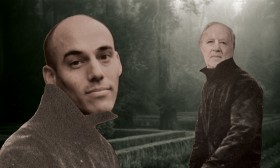
På filmskolen i København på fredag og lørdag skal jeg så blandt meget andet formodentlig høre Werner Herzog uddybe sin meget citerede udtalelse om ”… Oppenheimer’s depiction of power and violence: ’I have not seen a film as powerful, surreal, and frightening in at least a decade… unprecedented in the history of cinema.’ ” De ord fangede mig virkelig dengang, og så fulgte Errol Morris lige efter: ”… he praises Oppenheimer’s portrayal of violence and cinematic imagination: ’Like all great documentaries, ‘The Act of Killing’ demands another way of looking at reality. It starts as a dreamscape, an attempt to allow the perpetrators to reenact what they did, and then something truly amazing happens. The dream dissolves into nightmare and then into bitter reality. An amazing and impressive film.’ ” (blogs.indiewire.com)
Når Herzog og Morris siger sådan, bliver jeg mere end interesseret. Og fra jeg som det første så traileren på Vimeo var jeg rystet, helt bogstaveligt rystet, selv om jeg forstod, det var rekonstruktioner, jeg så. Men det var heller ikke fiktion, nej, det var omhyggelige genskabelser af erindringsbilleder og ikke af blotlagte fortrængninger, men iscenesættelser af de mest forfærdende hændelser og gerninger, disse medvirkende lever med som deres liv. Som noget selvfølgeligt, forstod jeg? Jeg skulle se den film om de indonesiske dødspatrulje-gangstere, som myrdede kommunister for magthaverne midt i 60’erne. Jeg ville egentlig ikke. Og nu skal jeg så høre Hezog og Oppenheimer tale om sådanne spørgsmål i to dage i træk. Det bliver sindsoprivende. (ABN 06-01-2015)
DICTA
Mens jeg fortumlet tænker videre over alt det, som skete i mig ved at lytte til de to dages samtale mellem Joshua Oppenheimer og Werner Herzog på Den danske Filmskole for en uge siden, hjælper kollega Tue Steen Müller mig ved at hitte dette blogindlæg fra kottke.org frem. Det kan for mig lige nu fungere som en slags huskeliste (for Herzog vendte ofte tilbage til et eller andet dictum, som han kalder disse sætninger) og dermed mulighed for videre overvejelse for en vigtig del af Herzogs bidrag disse dage. Resten står så tilbage som opgave. Og dertil kommer selvfølgelig især at få orden i tankerne om det, Joshua Oppenheimer sagde. Men altså indtil videre denne blogpost af Jason Kottke (ABN 18-01-2015)



